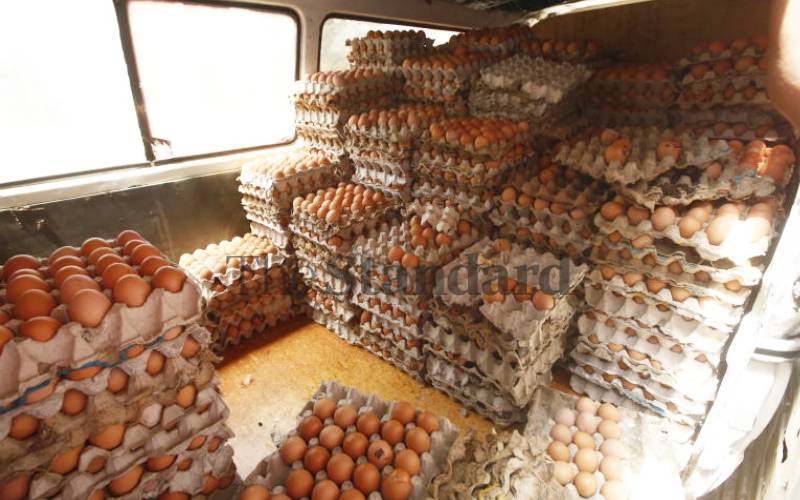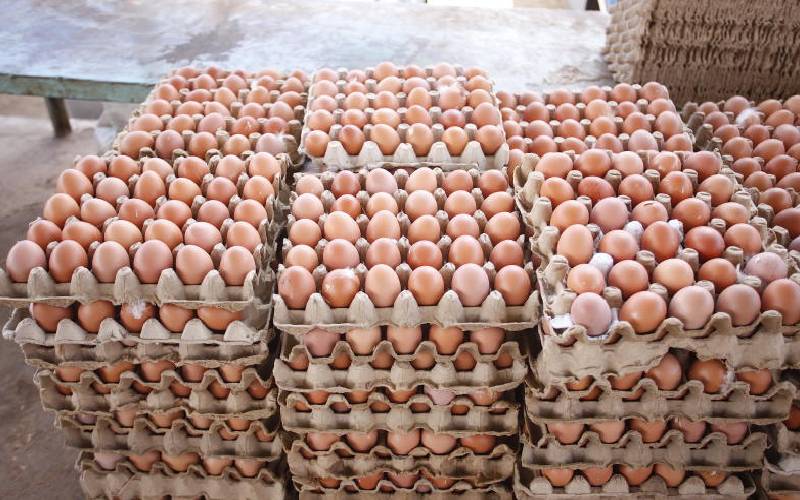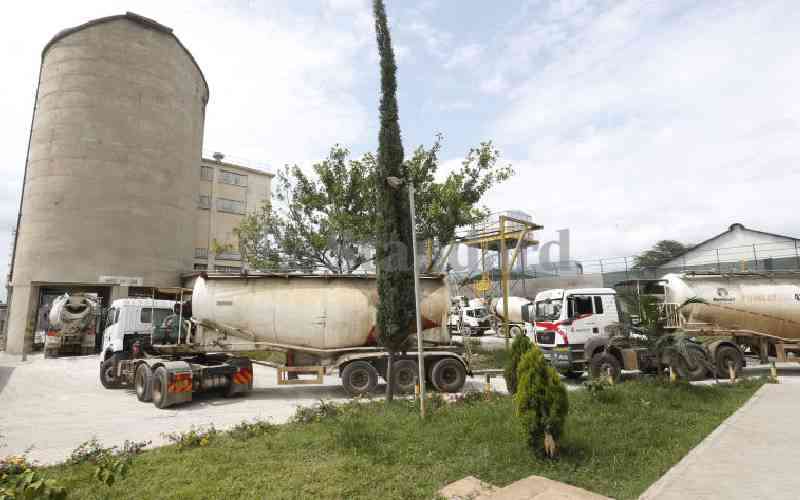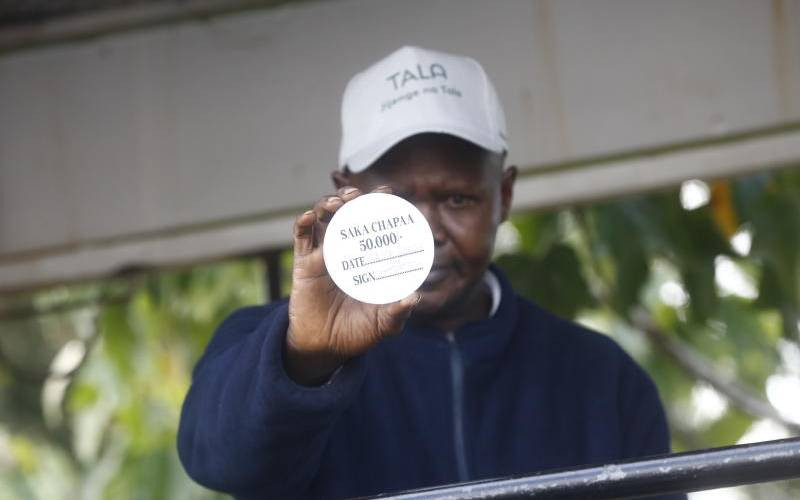
Uganda’s private sector has jumped into the trade spat with Kenya, claiming that its neighbour does not have what it takes to produce chickens and chicken products. [Christopher Kipsang,Standard]
Uganda’s private sector has jumped into the trade spat with Kenya, claiming that its neighbour does not have what it takes to produce chickens and chicken products.
Speaking to a Kampala daily, two high-ranking Ugandan business representatives said East African countries needed to know their strengths and capitalise on them.
“Uganda will always produce more eggs than Kenya. If you just think of the feeds that our poultry industry takes up, Uganda definitely produced more feeds,” said Simon Kaheru, chair of East Africa Business Council, Ugandan Chapter.
“And because of our climate, we will always produce more chicken and eggs than the rest of the region.”
He said the Uganda climate is favourable for the production of sunflower, the biggest ingredient in chicken feed.
“Ugandan producers are competing with Kenyans for the soya cake in Uganda,” said Poultry Association of Uganda Chair Andrew Rubaihayo in the same interview.
“That is why their eggs will never be cheaper than Ugandan eggs.”
This comes at a time when the trade war between Kenya and Uganda that was triggered by the decision by Nairobi to ban eggs from Kampala has quickly escalated into a diplomatic row, with Uganda retaliating by restricting some of Kenya’s raw and processed agricultural products.
It is a move that is counterproductive to both countries that are members of the East African Community (EAC), a free trade area that comprises five countries.

A boda boda rider transports an eggs trader to Daraja Mbili market in Kisii county on 23/11/2020. [Sammy Omingo, Standard]
Uganda is Kenya’s leading export destination. In 2020, Uganda took up the largest fraction of Kenyan exports at 11.2 per cent, or Sh72.2 billion, of the total export value, according to official data. This was an increase from 10.7 per cent, or goods valued at Sh64.1 billion in 2019.
Kenya was the second largest export market for Uganda in 2019, with the country’s goods destined to Kenya taking up 9.38 per cent, or Sh38.4 billion, of the total export value.
However, the current tiff that started with Kenya banning importation of chicken and chicken products to protect its farmers threatens to ruin this vibrant commercial relationship.
Experts have warned that consumers will be the main losers, with most of the poor Kenyan household being denied a cheap source of protein that is in high demand, but whose local production has not been able to keep up.
There are fears that some of the radical decisions are informed by the upcoming elections, with politicians keen to score cheap points to boost their standing among farmers.
A trade spat between the two countries is not new. The countries have already been at odds about imports of milk, sugar and maize.
The latest ban, says Tegemeo Institute research fellow Timothy Njagi, was inflamed by the Covid-19 pandemic, with India sweeping nearly all the raw materials used to manufacture chicken meal from Kenya’s source markets such as Uganda, Zambia and Malawi.
Consequently, layers mash, the main feed for layers, jumped to Sh2,600 per 70-kilogramme bag in October from Sh1,800 in March. This pushed up the cost of producing chicken and eggs.
As a result, Kenyan chicken farmers abandoned local manufacturers of chicken feed and moved to Uganda and Tanzania.
“This time it is bad because it is forcing farmers and animal feeds out of business,” said Dr Njagi.

Trays of eggs at Lakeview Estate in Nakuru County on April 4, 2021. [Harun Wathari, Standard]
In his Mashujaa Day Speech on October 1, President Uhuru Kenyatta ordered the Agriculture Cabinet secretary, jointly with the National Treasury, to come up with a framework that would facilitate the reduction of the cost of animal and chicken feed within seven days.
The National Treasury recently granted millers a 12-month import duty waiver on raw materials used in the manufacturing of animal feed.
National Treasury Cabinet Secretary Ukur Yatani said in a Kenya Gazette notice on December 10 that the waiver will run from November 1, 2021 to October 31 next year, helping 18 feed millers to import the inputs tax free.
The benefits of tax-free imports are expected to translate into reduced prices for farmers. Millers have been allowed to bring in 225,950 tonnes of yellow maize, 126,300 tonnes of soya beans meal, 58,250 tonnes of soya beans and 20,500 tonnes of cottonseed cake.
Njagi, an agricultural economist, doubts yellow maize will help a lot in lowering the cost of eggs and chicken, noting that the raw material that is mostly used to manufacture chicken feed is soya. “Yellow maize will reduce the price, but not significantly,” he said.
The government started the ban on Uganda eggs to protect local producers. However, because there is a huge deficit in Kenya, the ban will end up hurting consumers.
“We are in a common market with Uganda. Everybody loses, but it is the consumer who hurts a lot, especially the poor households in Nairobi,” Njagi said. “You are only denying them a cheap source of protein.”
Steve Kamwamu, a chicken farmer with 5,000 layers in Kisumu, told The Standard that while banning might be the right thing for a farmer, “considering everything, it is not the best way.”
“Looking at official data at the end of the year can be deceiving. For the eggs market the problem is the distribution of the frequency,” he said.
While there is a deficit in the market, the eggs from Uganda are imported almost at a certain time in the year, thus causing oversupply and thus lowering prices.
“It comes a lot at ago, and the traders would like to offload all of them at the same time,” said Kamwamu.
And because eggs are highly perishable, local traders will be forced to sell at the prevailing price as they cannot put the eggs on the shelf to sell at a later date. According to Kamwamu, Kenya imports about 60 per cent of the eggs consumed, with a majority coming from Uganda. The official figure tells a different story.
Figures from the Kenya National Bureau of Statistics (KNBS) show that the country produced an average of 88,166 tonnes of eggs last year, against less than 1,000 tonnes that were imported.
Analysts reckon this is because most of the eggs that get into the country are not declared.
Mr Rubaihayo said of the total egg production in Uganda, more than 70 per cent is exported to Kenya. Another 15 per cent goes to the Democratic Republic of Congo, a few to South Sudan and the rest is consumed locally.
Official data shows that Uganda produced 45,000 tonnes of eggs in 2019, which means that 31,850 might have found their way into Kenya.

Eggs on sale at Wangige Market in Kiambu County. [Wilberforce Okwiri, Standard]
Some experts point out that in Uganda, the government subsidies the production of chicken and chicken products as part of President Yoweri Museveni’s import substitution programme.
Moreover, Kenya imports most of the raw materials used to manufacture chicken feed such as maize, cotton cake and soya cake from Uganda as they are not taxed, said Kamwamu.
Kamwamu says the solution would be to control the volumes and regulate prices.
Using the rules of origin, the government should have tried to determine if the eggs were locally produced, if they were not then they should be slapped with tariffs or embargo, analysts say.
Government should also make sure the cost of production is low. There is also a lack of extension services, and policy on government support, farmers training, and subsidies for chicken food.
There has not been an emphasis on policy on poultry farming and yet poultry is key on nutrition and value-addition,” said an insider at the Ministry of Agriculture who did not wish to be identified. Some analysts do not think the solution is for Kenya to try and beat Uganda as Uganda enjoys a comparative advantage.
However, Kenya also contributes some raw materials used to manufacture chicken and chicken products.
One of the ingredients of chicken feed is lime as a source of calcium. Data shows 90 per cent of the lime used in the Ugandan farms is imported from Kenya.
“The feeders and drinkers are also coming from Kenya. Here in Uganda, the plastics companies cannot make those drinkers and feeders,” said Rubaihayo. Kenyans also sell their chicks to Ugandan farmers.
There are fears that if the ban persists, the smuggling of the product across the borders will increase.
The current spat is one of the many ups and downs of the EAC bloc, one of the most successful regional economic communities in Africa, according to a report that was produced jointly by the African Development Bank, the African Union Commission and the Economic Commission for Africa.
The 2016 Africa Regional Integration Index found that Kenya was among the best performers in regional integration in the continent. It led in three of the five dimensions that were used to design the index. The dimensions where Kenya was a star performer included regional trade, productive integration and free movement of people.
 The Standard Group Plc is a multi-media organization with investments in media platforms spanning newspaper print
operations, television, radio broadcasting, digital and online services. The Standard Group is recognized as a
leading multi-media house in Kenya with a key influence in matters of national and international interest.
The Standard Group Plc is a multi-media organization with investments in media platforms spanning newspaper print
operations, television, radio broadcasting, digital and online services. The Standard Group is recognized as a
leading multi-media house in Kenya with a key influence in matters of national and international interest.











